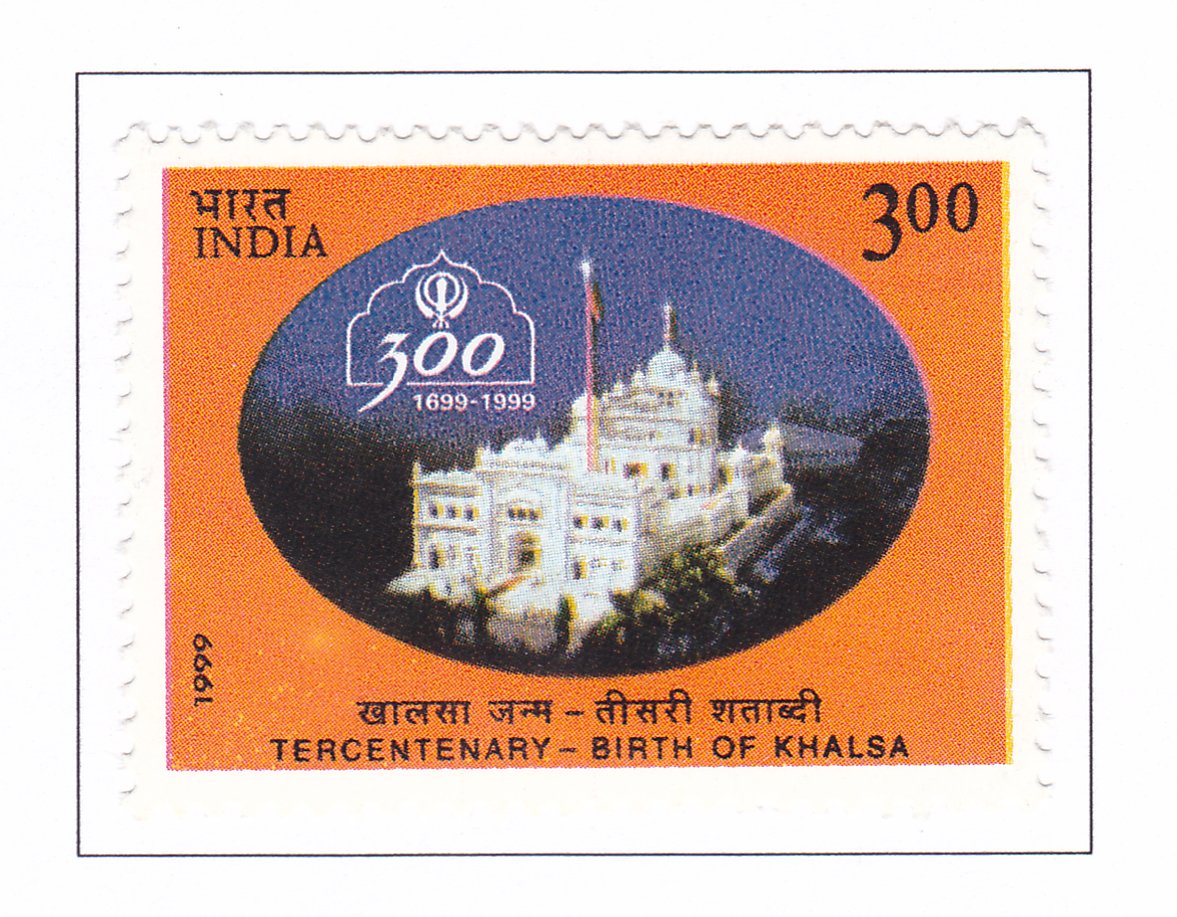300th Anniversary of the Khalsa Panth

Technical Data
| Date of Issue | April 9, 1999 |
|---|---|
| Denomination | Rs. 3 |
| Quantity | 1,500,000 |
| Perforation | comb 13½ x 13 |
| Printer | Security Printing Press, Nashik |
| Watermark | No Watermark |
| Colors | Multicolor |
| Catalog Codes |
Michel IN 1683 Stamp Number IN 1743 Yvert et Tellier IN 1450 Stanley Gibbons IN 1846 |
| Themes | Anniversaries and Jubilees | Architecture | Temples |
Table of Contents
Commemorative Stamp Set: Tercentenary of the Khalsa
Design Elements:
- Guru Gobind Singh and the Khalsa: A stamp featuring an inspiring image of Guru Gobind Singh initiating the first five Sikhs (Panj Pyare) into the Khalsa order on Baisakhi Day in 1699 at Fort Kesgarh, Anandpur Sahib. The design would include symbolic elements such as the double-edged broadsword (Khanda) and the steel bowl used in the ceremony.
- The Five Emblems (Panj Kakar): A stamp illustrating the five emblems (Kesh, Kangha, Kara, Kachera, and Kirpan) that define the Khalsa identity, highlighting the distinctiveness and spiritual significance of these symbols.
- Historic Fort Kesgarh Sahib: A stamp depicting the historic site of Fort Kesgarh Sahib where the Khalsa was founded, showcasing the grandeur of the fort and its importance in Sikh history.
Cultural and Historical Significance:
- Foundation of the Khalsa: The stamp set commemorates the founding of the Khalsa, a pivotal event in Sikh history that transformed the community into a unified force of saint-soldiers committed to justice, equality, and protection of the oppressed.
- Guru Gobind Singh’s Legacy: The stamps honor Guru Gobind Singh’s visionary leadership and his efforts to create a casteless, egalitarian society through the Khalsa.
- Sikh Contribution to Indian Independence: The stamps also acknowledge the significant role played by the Khalsa in India’s struggle for freedom from British rule and the ongoing contributions of Sikhs to the nation’s unity and welfare.
Usage:
- Educational Resource: The stamps can be used in educational materials to teach about Sikh history, the foundation of the Khalsa, and its impact on Indian society.
- Philatelic Collection: A valuable addition to philatelic collections, especially for those interested in religious history and cultural heritage.
- Cultural Celebration: Used in Sikh communities and beyond, the stamps would be a symbol of pride and a way to celebrate the rich legacy of the Khalsa.
Importance of the Commemorative Stamp Set:
- Preservation of Heritage: This set serves to preserve and propagate the history of the Khalsa, ensuring that the story of its founding and the values it represents are remembered and respected.
- Promotion of Sikh Values: By celebrating the Khalsa, the stamps promote the core values of Sikhism—universal love, equality, justice, and the courage to stand against oppression.
- National Unity: The stamps highlight the contributions of the Sikh community to India’s unity and independence, fostering a sense of national pride and solidarity.
Example of the Stamp Design:
- Guru Gobind Singh and Panj Pyare: A powerful portrayal of Guru Gobind Singh with the Panj Pyare, surrounded by symbols of the Khalsa initiation, with a background of Fort Kesgarh Sahib.
- Panj Kakar: A detailed depiction of the five emblems of the Khalsa, arranged in a visually appealing manner to emphasize their spiritual and cultural significance.
The Commemorative Stamp Set Might Include:
- Baisakhi Festival: A stamp featuring the grand Baisakhi festival, showcasing the large congregation that gathered for the historic event in 1699.
- Khanda Symbol: A stamp displaying the Khanda, the symbol of the Sikh faith, representing the core beliefs of the Khalsa.
- Sikh Martyrs: A stamp paying tribute to the martyrs of the Khalsa, who laid down their lives in the fight against tyranny and for the freedom of India.
Significance:
- Spiritual and Cultural Identity: The stamp set underlines the spiritual and cultural identity of the Khalsa, highlighting its importance in the Sikh faith.
- Legacy of Resistance: It commemorates the legacy of resistance against oppression, a key theme in Sikh history, and the enduring spirit of the Khalsa.
- Global Sikh Community: The stamps celebrate the contributions of the Sikh community to global welfare, echoing the daily prayer for the well-being of all humanity, “Sarbat da bhala.”
